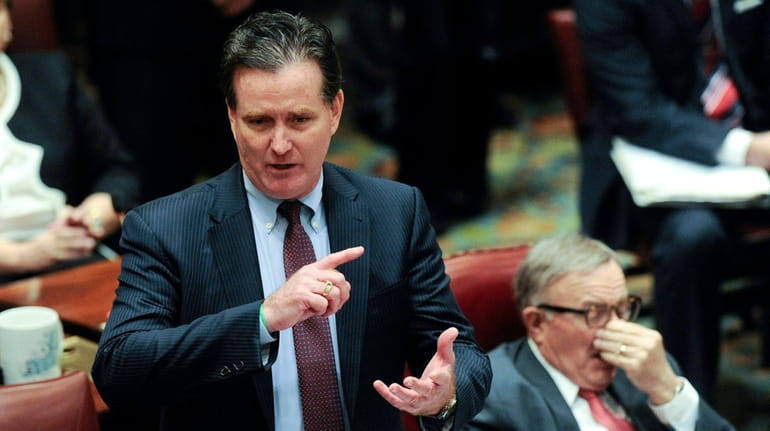Cuomo, lawmakers grapple over $5B water quality bond act

State Senate Majority Leader John Flanagan (R-East Northport) is reportedly making his conference's proposal for a $5 billion water quality bond act a top priority in state budget negotiations. Flanagan is shown here Jan. 4, 2017, in Albany. Credit: AP / Hans Pennink
ALBANY — Legislative leaders and Gov. Andrew M. Cuomo are wrestling over a potential $5 billion solution to the decades-old problem of ancient, crumbling water and sewer systems statewide and the pollution threat caused by hundreds of thousands of septic systems on Long Island.
State Senate Majority Leader John Flanagan (R-East Northport) is making his conference’s proposal for a $5 billion water quality bond act a top priority in state budget negotiations with Cuomo and Assembly Speaker Carl Heastie (D-Bronx), a legislative source close to negotiations said.
Cuomo has proposed a $2 billion water quality project in his budget, which could be done through the general fund or through borrowing in a bond act. The Assembly’s Democratic majority won’t complete its budget counterproposal, called a one-house budget, until March 13.
A state-funded program could eliminate or reduce the impact of addressing Long Island’s septic problem that threatens Long Island Sound, commercial fishing and drinking water without burdening what are already some of the nation’s highest local property taxes. The septic issue and runoff of fertilizer from farming and private homes has left dead fish, closed dirty and smelly beaches, and contaminated wells that destroy home values and pose health threats.
The Senate’s proposed $5 billion Clean Water Bond Act would devote $1.5 billion to protect drinking water supplies, watersheds and natural resources and to develop projects to restore water quality. The bill sponsored by Senate Health Committee chairman Kemp Hannon (R-Garden City) would also spend $3.5 billion to repair, replace and update pipes and facilities critically needed upstate and for “updating and replacing septic systems,” and implementing new filtration systems most needed on Long Island.
A Senate report released last year after months of public hearings found 360,000 homes in Suffolk County alone don’t have municipal sewers and that causes about 70 percent of the nitrogen pollution in the area’s waterways. The nitrogen from septic systems leads to algal blooms that cut oxygen in the water and reduce plant life in coastal marshes, which help protect Long Islanders against severe waves and flooding, the report found.
“As we started to look into some aspects of water contamination and supply it just got bigger and bigger,” Hannon said. “As we got into it we just realized a tremendous amount of money is needed.”
He said internal discussions are being held on whether to quickly pass Cuomo’s $2 billion plan and then go to voters next year for an additional $5 billion. “But that’s not decided,” Hannon said.
Another legislative source said the Assembly bill will include support for Cuomo’s $2 billion proposal but will call for it to be divvied up by certain types of water quality projects and related environmental projects. The Assembly majority will also be willing to consider borrowing the money through bonding and also borrowing beyond $2 billion, said the source, who spoke on the condition of anonymity.
Hannon’s Senate bill also has support in the Democratic-led Assembly. There, Environmental Conservation Committee chairman Steven Englebright (D-Setauket) is co-sponsoring the same Clean Water Bond Act.
Those involved in negotiations agree on at least two obstacles to agreement.
Under the state constitution, bond acts must be approved by voters. Hannon proposes this referendum be placed on the November ballot. That off-year Election Day would attract a low turnout, which makes mobilizing support easier.
It’s a dicey time for government to ask the public to trust it with borrowing $5 billion on the taxpayers’ tab, said one official close to negotiations. However, water quality crises, from a small town in the North Country to Buffalo to Long Island, have provided momentum for action this year for a massive water quality project.
There is also a sore spot between Cuomo and the Senate Republicans who have diverged since they were closer partners in Cuomo’s first term. Flanagan is insisting funding approved by the legislature include detailed projects with input by lawmakers in a legal agreement. That’s how most big spending was done before Cuomo took office in 2011.
Many legislators see Cuomo as trying to bypass the legislature in his 2017-18 budget proposal.
Cuomo has, in other areas of spending such as economic development, reduced the lawmakers’ role, citing past scandals and inefficiencies in what he called pork-barrel spending. But Cuomo’s spokeswoman declined to comment on whether the governor would fight Flanagan’s push for detailing projects before the money is allocated. Cuomo has said lump sum allocations are the most efficient method of addressing the greatest need with the least amount of politics directing funds.
“Should it be regional? That probably should be a part of it,” Flanagan said Feb. 13 after meeting with local government officials. Traditionally, that regional approach has provided a third of bond act money to Long Island, with a third to New York City and a third for upstate with input by legislators.
“The legislature, senators, Assembly members, on both sides, both political stripes, they have a very good working knowledge of what goes on in their districts and I think we should play a critical and pivotal role in making those decisions,” Flanagan said.
Legislators and Cuomo declined to comment to avoid disrupting the private negotiations for the budget that is due by April 1.
“We are absolutely delighted that they are discussing this at this level,” said William Cook of the Citizens Campaign for the Environment that lobbies on environmental issues. “The governor’s and the Senate proposal are not mutually exclusive; they complement each other.”
“But it’s got to be in the budget,” Cook said, referring to a trend under Cuomo in which the biggest deals, tied to other big proposals, are struck in private talks by the April 1 budget deadline even though nearly three months would remain in the session.
“It’s got to be done within the next 31 days,” Cook said Feb. 27. “This is the year for infrastructure and water quality work.”

